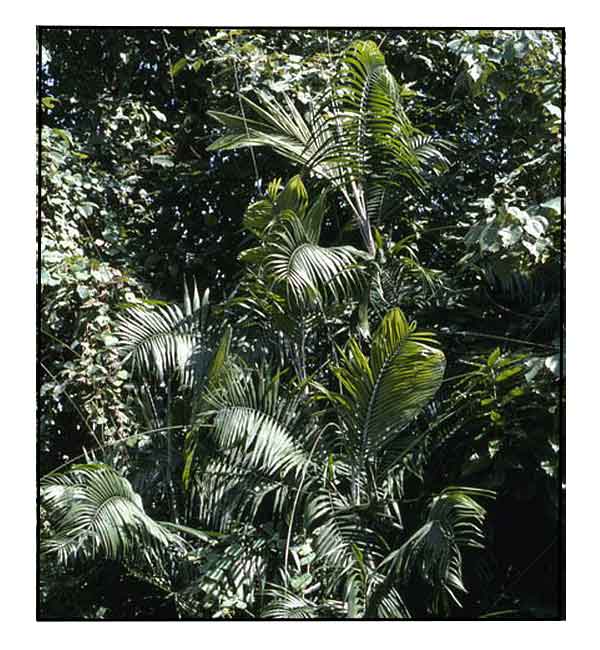 Gen info Gen info
- Calamus is a genus of flowering plants in the palm family, Arecaceae, with an estimated 400 species in the genus, all native to tropical and subtropical Asia, Africa, and Australia.. (11)
- Rattans are naturally found in the Philippine dipterocarp forests and are distributed throughout the country. Four genera, namely Calamus, Daemonorops, Korthalsia, Plectocomia, with 64 species are found in the country.
- Calamus, with 44 species and 23 varieties, is the largest of the four genera. It is widely distributed, with some species as narrow endemics and confined to specific islands or mountains. Daemonorops is the second largest genus with 14 species and one variety, also widely distributed, many of which are confined to islands and mountains. (12)
- Plectocomia species in the Philippines are P. elmeri, which is endemic in the Philippines, and P. elongata, which is common in Thailand, the Malay Peninsula, m Sumatra, Java, and Borneo
- Calamus rattan species in the Philippines include: Abuan (Calamus diepenhorstii), Apas (C. reyesianus),
Arorog (C. javaensis), Arugda (C. arugda), Babuyan (C. usitatus), Balala (C. multinervis), Banakbo (C. megaphyllus), Bayabong (C. manillensis), Borangan (C. ornatus), Butarak (C. vidalianus), Dagdag (C. siphonospathus), Dalimban (C. melanorhynchus), Ditaan (C. ochrolepis), Douung-douung (C. cumingianus), Hamlis (C. discolor), Kalapit (C. microcarpus), Kulakling (C. microsphaerion), Kurakling (C. spinofolius), Labit (C. microsphaerion), Lambutan (C. halconensis var. dimorphacanthus), Limuran (C. ornatus), Matkong (C. mitis), Palaklakanin sumulid (`Daemonorops ochrolepis), Palanog (C. symphysipus), Palasan (C. merrillii), Panlis (C. ramulosus), Pitpit (C. curranii), Sababai (C. elmerianus), Saba-ong (C. grandifolius), Sarani (C. moseleyanus), Sika (C. caesius), and Tumalim (C. mindorensis). (12) (13)
- In the Philippines, rattan is
a significant source of domestic products and furniture export business.
- Etymology: The genus name Calamus derives from Greek word kalamos, meaning "reed". Specific epithet usitatus derives from Latin, meaning "ordinary, usual".
- Sweet flag is a common name shared by Calamus species. However, they lack the sweetness; in fact, Calamus is one of the strongest tasting roots in the herbal kingdom, intensely pungent and/or acrid, intensely aromatic and intensely bitter. (8)
 Botany Botany
• Calamus usitatus is a spiny evergreen, climbing palm producing a slender to moderate clustering, thicket-forming rattan with stems to rarely more. Stem without sheaths to 5-10 mm, with sheaths 10-23 mm; intei to 15 cm; sheaths bright green, very sparsely to densely armed with scattered golden brown to 45 mm, and caducous pale grey indumentum; sometimes main body of she unarmed, but even when so, spines present around leaf sheath mouth; spines aroui sheath mouth ± erect, much larger than the rest, borne close together in a neat row, 11 to 12 cm. Knee conspicuous. Ocrea to 5 mm, very densely armed with minute spiculezm or spines to 3 mm. Flagellum to 1.5 m. Leaf ecirrate to 90 cm, frequently less, including petiole to 20 cm; petiole armed with few horizontal golden brown spines; leaflets about 30 on each side of the rachis, close, regular, (in Sabah; most Philippine populations have grouped leaflets), the largest to 30 x 1.4 cm armed with black bristles along margins, 3 main veins on upper surface, and midrib beneath. Male and female inflorescences superficially similar, to 2 m? with 5 or more partial inflorescences; bracts on main axis close tubular, variously armed with golden brown spines but always with apical tufts of erect slender spines to 20 mm; partial inflorescences to 40 cm, with curving axes and curved rachillae; male rachilla to 40 x 2 mm; female rachilla to 50 x 3 mm. Mature fruit ovoid, about 8 x 6 mm, with a short beak to 1 mm, and covered in 18 vertical rows of straw-coloured scales. Seed c 6 x 4 mm. Endosperm apparently homogeneous. (2)
Distribution
- Native to the Philippines
- In coastal areas and secondary forests, at low and medium altitudes.
- Also native to northeast Borneo, Sulawesi, Maluku.
Constituents
- Quualitative screening of methanolic extract of shoots yielded flavonoids, coumarins, reducing sugars, glycosides, terpenes/terpenoids, phenolics, and quinones, with absence of proteins, saponins, alkaloids, tannins, steroids/phytosterols and anthraquinones. (see study below) (4)
- Study of methanol extract of shoots yielded Total Phenolic Content (TPC) of 62.81 mg GAE/g dried extract, and Total Flavonoid Content (TFC) of 1.744 mg QE/g dried extract. (4)
Properties
Study suggest antioxidant property.
Parts used
Shoots.
Uses
Edibility
- Shoots are edible. If leaf sheaths are left in place until just before cooking, the shoots remain fresh for up to one week.
- Fruits reportedly edible; eaten fresh, out of hand. (6) The taste variedly described as refreshing, acidic, or lacking flavor.
Folkloric
- No reported folkloric medicinal use in the Philippines.
- Roots reportedly used in traditional medicine for various ailments. (No reports found on specific use.)
Others
- Crafts: Stems are of good quality, used for basketry, handicrafts, fishing implements, and tying. (3) Leaves are folded and used for roofing.
- Agroforestry: Helps stabilize the soil, especially in wetland areas. Robust root system helps prevent erosion.
Studies
• Antioxidant / Shoots: Study evaluated rattan root methanolic extracts for phytochemicals and antioxidant activity. Calamus usitatus demonstrated effective scavenging activity against superoxide anions at 227.3 µg/ml. C. usitatus showed significant reducing power by FRAP assay at53.1 µg/mL by 95.04%. By DPPH assay, C. usitatus showed scavenging activity with IC50 of 681.57 µg/mL. (see constituents above) (4)
Availability
Wild-crafted.
|

![]()





